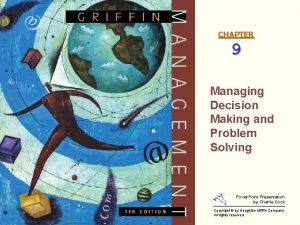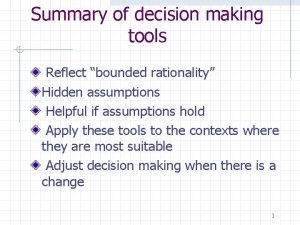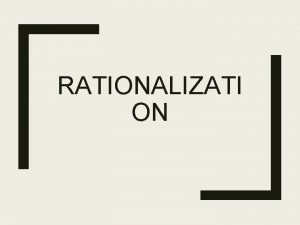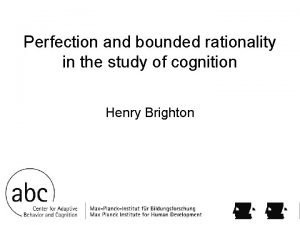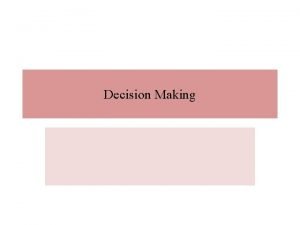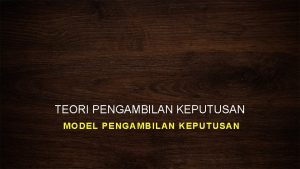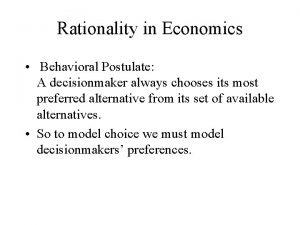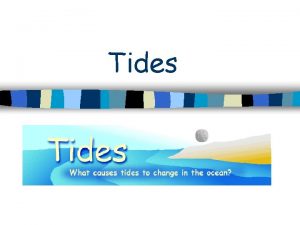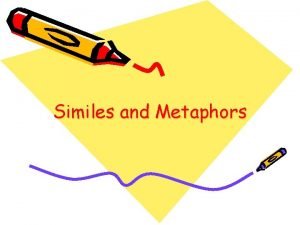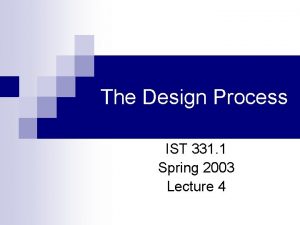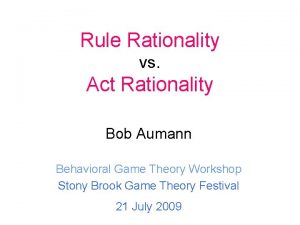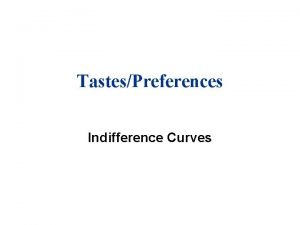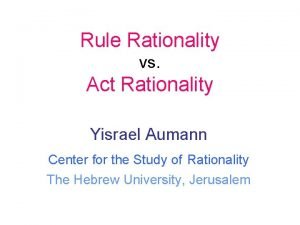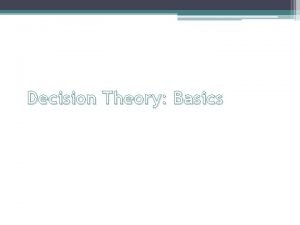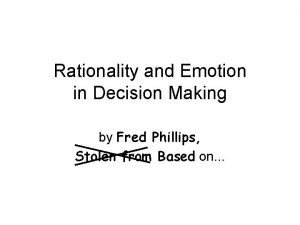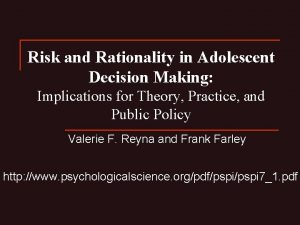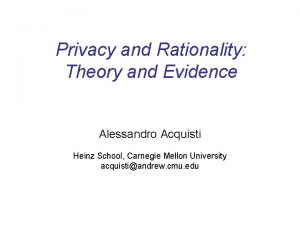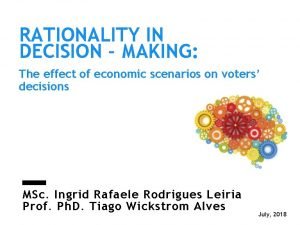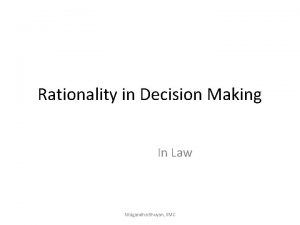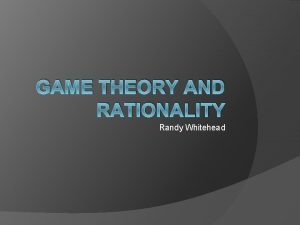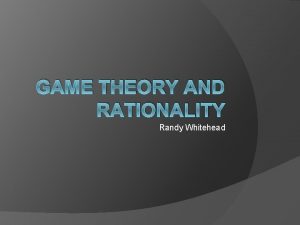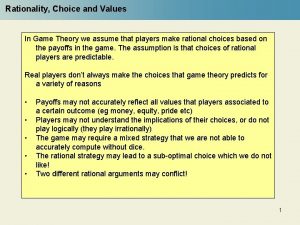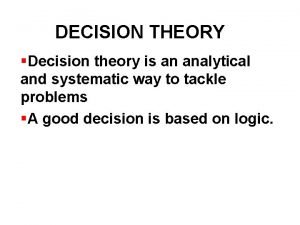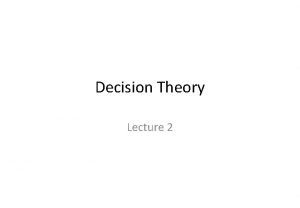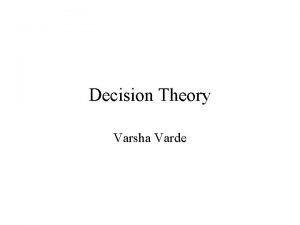Spring 2016 Decision Theory Decision Theory and Rationality










![Darwin’s Method This “Mary is the question “ [sic – his word] Children — Darwin’s Method This “Mary is the question “ [sic – his word] Children —](https://slidetodoc.com/presentation_image_h2/3ae10e99d89c015a9050ce9f7018f473/image-11.jpg)














- Slides: 25

Spring, 2016 Decision Theory

Decision Theory and Rationality Wow – this is actually the method that our government and others use to make decisions about life and death and about the value of life versus possible profit for the whole. For example, is the benefit we get from coal (or atomic energy) worth the cost in death and illness that come from both? Can we follow Ben Franklin and just add up the costs and benefits? That is exactly what we do.

This is decision theory and it is Rational! Be Objective & Rational! Face Facts! Accept Reality! Whose idea of “reality? ” “Rational” just means following rules. In 1947 Neumann & Morgenstern invented “Decision Theory. ” In their view, …. Utility, defined as choice (think of the matching law), times probability equals expected utility, or choice. So (utility) (choice) equals expected utility! Hooray! We can build that new coal mine or blow the tops off more mountains. With that energy, we can power more used car lots, tanning salons, and only kill a few thousand people. All we have to do is assign values to the utilities and costs.

To be rational, we assume…. Invariance: Utilities of alternatives remain stable Transitivity: Utilities vary along one dimension, so that if A is preferred to B and B is preferred to C, then A will be preferred to C. Substitutability: Equal utilities will be substitutable. Dominance: Often, one characteristic will determine choice. CONSIDER: The tragedy of the commons ( Hardin, 1968) Pollution by companies The theatre fire in Chicago in 1903, where 602 died. The Coolidge Effect [see below]

So…Rational for Whom – the individual or the group? How does decision theory work? Check Mook’s examples…. Subjective utilities Ue =PU 1 + PU 2 + …. . PUn 1. Should you accept $1 or flip a coin for a chance of $5? That is, (1. 0)($1) + (0. 0)($0) = $1, but… (. 5)($5) +. 5($0) = $2. 50 2. Should you take $2 or accept a 10% chance of $100? That is, (1. 0)($2) + (0. 0)($0) = $2, but… (. 10)($100) + (. 90)($0) = $10 3. should you bet $10 on a roll of a die for $30 if one dot comes up? That is, (1. 0)($10) + (0. 0)($0) = $10, but. . . (1/6)($30) + (5/6)($0) = $5 [can be –U also]

Crime & Punishment in NYC Prior to the 1990 s penalties for drug trafficking were harsh, but not effective, since the probability of arrest, successful prosecution, and conviction was low. This meant that –Ue was small The same was true for other crimes considered less serious than those inflicting direct damage on victims. That’s why Times Square was an unsavory place. Change came when all crimes, even minor ones like keying cars and tagging, were punished. Harsh penalties are meaningless if the chance of conviction is small. Or maybe it was the opening of the Disney Store. (No – the drop in crime was city-wide. )

Decision Theory and the Coolidge Effect Recall how sociobiology explains the effects of variety on sexual activity in male rats, rams, and other animals. Males should have as many sexual partners as possible to ensure the passing on and spreading of their genes. But decision theory suggests that females counter this tendency by raising the “cost of fatherhood. ” The stickleback male must build a nest and go through complex displays before a female will cooperate. A male bower bird must build a bower and decorate it – whew! A ring dove may have to bow-coo for hours or days before the female ovulates – that’s lots of effort. After all that, why would a male pay such a price to attract another female?

Hey – what is “utility, ” anyway? As decision theory uses the word, it’s “value, ” or “goodness/badness, ” or other fuzzy words. The best synonym is “preferredness, ” so… Utility is relative and always involves choice. “Cleaning the bathroom” has high utility only relative to “not cleaning the bathroom. ” Even if restricted to $money$ amounts, utility doesn’t increase linearly – double the money is not double the utility. First, money and commodities (and services) show diminishing marginal utility – the more you have the less is the utility of an additional unit.

Gene Galanter, Ben Franklin, + Charles Darwin Galanter (1962, 1990) tried to scale the utility of added amounts of money by asking people – “If you had $5, 000 (or $10, 000, or whatever), how much would it take to double its utility/value? ” People said that a doubling of utility required a doubling of the square root of the original value. √$5, 000 = about 70 and double that is 140, or √$20, 000 So twice the utility of $5, 000 comes with $20, 000 √$15, 000 = about 122, doubled is 244, or √$60, 000. Forgetting about square root functions, Galanter’s finding suggests that a doubling in utility/value seems to require a quadrupling in quantity of money.

Franklin’s and Darwin’s “decision model” Franklin’s (1779) advice to his nephew: which girl to marry? List the pros and cons of two alternatives on two sides of a sheet of paper. Estimate the values (+ and -) of each. Algebraically add and there’s the answer. (Right!) Darwin wondered whether to marry his cousin, Emma Wedgewood, in 1839.
![Darwins Method This Mary is the question sic his word Children Darwin’s Method This “Mary is the question “ [sic – his word] Children —](https://slidetodoc.com/presentation_image_h2/3ae10e99d89c015a9050ce9f7018f473/image-11.jpg)
Darwin’s Method This “Mary is the question “ [sic – his word] Children — (if it Please God) — Constant companion, (& friend in old age) who will feel interested in one, — object to be beloved & played with. — —better than a dog anyhow. — Home, & someone to take care of house — Charms of music & female chit-chat. — These things good for one's health. — Forced to visit & receive relations but terrible loss of time. — My God, it is intolerable to think of spending ones whole life, like a neuter bee, working, & nothing after all. — No, no won't do. — Imagine living all one's day solitarily in smoky dirty London House. — Only picture to yourself a nice soft wife on a sofa with good fire, & books & music perhaps — Compare this vision with the dingy reality of Grt. Marlbro' St. Marry — Marry Q. E. D.

But… Not Mary No children, (no second life), no one to care for one in old age. — What is the use of working 'in' without sympathy from near & dear friends—who are near & dear friends to the old, except relatives Freedom to go where one liked — choice of Society & little of it. — Conversation of clever men at clubs — Not forced to visit relatives, & to bend in every trifle. — to have the expense & anxiety of children — perhaps quarelling — Loss of time. — cannot read in the Evenings — fatness & idleness — Anxiety & responsibility — less money for books &c — if many children forced to gain one's bread. — (But then it is very bad for ones health to work too much) Perhaps my wife wont like London; then the sentence is banishment & degradation into indolent, idle fool —

Decision Theory Does Not Fit Us: We Are Not Rational Ben Franklin’s and Darwin’s method has been shown to be a really bad idea. In daily life we are not rational decision makers.

We are not Rational Decision Makers: We estimate probabilities poorly. Utilities are not constant. We don’t have time and we don’t care. Think about Bernoulli’s Function (1738) Amos Tversky & Daniel Kahneman did and Kahneman won the Nobel Prize in 2002. U+ gains {dimin. Mar. Util. } loss gain steeper Ulosses

Tversky & Kahneman: Risk Taking $800 or 85% chance for $1, 000? That’s Ue of $800 or $850 (. 85)($1, 000) Almost all subjects take the sure $800 The alternative includes a 15% chance of nothing. $250 or 25% chance for $1, 000? Same Ue, but 84% of subjects take the $250 Regarding perceived gains, we are risk averse. However……How Are about perceived losses? we stupid, or what?

Perceived Losses – Risk Seeking? Should you lose $800 certain? Or bet to chance. 85 to lose $1, 000? Yes, this choice. How about a sure loss of $750 (13% choose) or… 75% loss of $1, 000? (87% choose) WHAT’S THE STORY? Check: “insurance” Check A & B choices: A. Sure loss of $50 B. 25% chance to lose $200 [80% choose] Different choice: A. Pay $50 to avoid 25% chance to lose $200 (65%) Dopey… the alternatives are the same

Lung cancer surgery: If the patient is told that 80% survive…versus… 20% die – will person elect surgery? HERE IS THE BEST EXAMPLE cited by TVERSKY & KAHNEMAN

The Asian disease that will kill 600 Plan A: 200 people will be saved Plan B: p(1/3) 600 people saved p(2/3) none saved -------------OR---------------------------- Plan C: 400 will die Plan D: p(1/3) none will die p(2/3) 600 die

The Asian disease that will kill 600 Plan A: 200 people will be saved (72%) Plan B: p(1/3) 600 people saved p(2/3) none saved (28%) -------------OR---------------------------- Plan C: 400 will die Plan D: p(1/3) none will die p(2/3) 600 die (22%) (78%)

The Alternative: Plan C: 400 will die (A: 200 will be saved, 22% choose C) They are the same choice. 72% choose A. Plan D: p(1/3) none will die (78%, but B = 28%) p(2/3) 600 die A and C are the same choice B and D are the same choice BUT – hundreds of subjects choose A (72%) over B And they choose D (78%) over C. BUT WHY? ? The answer is FRAMING – how is the question phrased? “saved” seen as gain, so risk averse, choose A “die” seen as loss, so risk seeking, choose D

We all choose gains (lives saved) over losses (deaths). When it’s the same choice – the words “saved” or “lost” do the trick. Schemas, Scripts, Mindlessness…. . Copier example… “Request Only: ” Excuse me, I have 5 (20) pages, may I use the copier? . 60, . 24 “Justify…” because I’m in a rush. ”. 94, . 42 “Placebo” “because I have to make copies. ”. 93, . 24 More Mindlessness – Availability San Antonio or San Diego? Manchester United or Shrewsbury Town?

AVAILABILITY Frequency of Lethal Events Lung cancer stomach cancer Botulism lightning Tornado asthma All diseases all accidents Pregnancy All accidents stroke Diabetes breast cancer Tuberculosis fire and flames Emphysema leukemia appendicitis

Lethal Events 2 Lung cancer 1/1. 25 stomach cancer Botulism 1/52 lightning Tornado 1/21 asthma All diseases 16/1 all accidents Pregnancy 1/2 appendicitis All accidents 1/1. 85 stroke Diabetes Tuberculosis Emphysema 1. 25/1 breast cancer 1/2 fire and flames 1. 5/1 leukemia

Pause a Bit… Representativeness Coin flip: which more likely? HTTHTHHTTH or… TTTTTT? You better have the right answer! Imagine births in a city during a week: Boys/girls How = 6/10 – could happen… about 60/100 – equally likely?

Back to the Asian Disease: Just the Words? Plan A: 200 will be saved 72% choose Or………. . Plan B: p(1/3) 600 saved 28% choose p(2/3) none saved Plan C: 400 will die (22% choose C) Or………… Plan D: p(1/3) none will die (78% choose D) p(2/3) 600 die Again : A (72%) is the same as C (22%) B (28%) is the same as D (78%)
 Decision making under bounded rationality
Decision making under bounded rationality A formal organization based on rationality and efficiency
A formal organization based on rationality and efficiency Rational decision making model
Rational decision making model Rationalization examples
Rationalization examples Bounded rationality
Bounded rationality Bounded rationality example
Bounded rationality example Pengertian bounded rationality
Pengertian bounded rationality Economic rationality
Economic rationality Rationality through reasoning
Rationality through reasoning Cast of spring, summer, fall, winter... and spring
Cast of spring, summer, fall, winter... and spring Spring summer autumn winter dates
Spring summer autumn winter dates Objectives of decision making
Objectives of decision making Slidetodoc.com
Slidetodoc.com Decision tree and decision table
Decision tree and decision table Smkvqmuzwv4 -site:youtube.com
Smkvqmuzwv4 -site:youtube.com Astro quiz 2019 questions and answers round 2
Astro quiz 2019 questions and answers round 2 Astro quiz 2016 questions and answers
Astro quiz 2016 questions and answers Widows and orphans word 2016
Widows and orphans word 2016 Spring tide and neap tide
Spring tide and neap tide The sky at noon is like simile
The sky at noon is like simile Spring, summer, autumn and winter
Spring, summer, autumn and winter Spring tide vs neap tide
Spring tide vs neap tide Ist spring design and validation
Ist spring design and validation Mondays chils
Mondays chils Conservation of mechanical energy
Conservation of mechanical energy Rj spring rubber and metal parts
Rj spring rubber and metal parts
